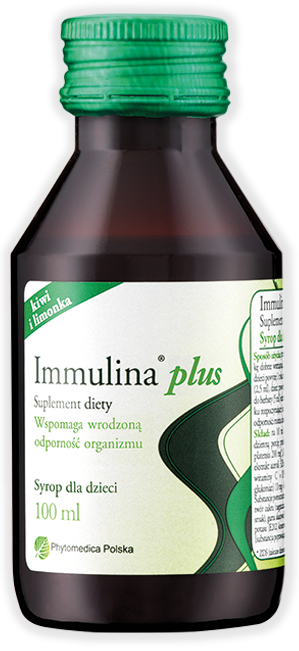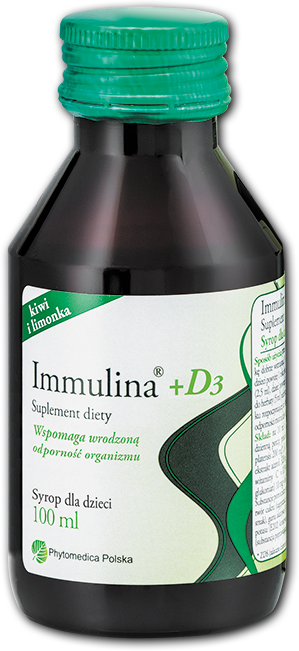 |
 |

There are periods in human life when taking care of immunity is of particular importance. This is primarily the period of early childhood, i.e. from the first year of life to the period of puberty and the period when the immune system is still developing and maturing, and in older age, when the immune system, like the whole body, is aging and begins to function less and less efficiently. Immulina Plus in the form of syrup has been developed especially for children, so that in this form the preparation can be easily and conveniently given to the child.
Immulina Plus syrup provides the following set of active ingredients in one measure (2.5 ml or ½ teaspoon):
- 25 mg vitamin C = 50 % RDA in rutoside complex from acerola extract
- 2,5 mg zinc = 50 % RDA
- 50 mg lipoplysaccharide complex (LECPEEN) from spirulina extract
- 32,5 mg β-glucan from baker's yeast extract
RDA = recommended daily allowance. Dietary Reference Intake values (DRI) are not used in young children.
Immulina Plus does not contain vitamin D3 or selenium.
Acerola fruit extract (Malpighia glabra) is not only an extremely rich natural source of vitamin C. In addition, vitamin C is in a complex with rutosides, i.e. rutin and hesperidin, which ensure the health and tightness of blood vessels, including capillaries in the mucous membranes, which it can prevent the penetration of microorganisms through the mucous membranes and may have a beneficial effect in the case of swelling of the mucous membranes. In addition, vitamin C is gradually released from this complex, which improves its stability and biological use by the body.
If you would like to read more → Hesperidin - benefits and uses..
If you would like to read more → Top 4 Rutin Benefits
Vitamin C doses for children and adolescents
The daily dose of vitamin C in children (and infants) is 2 milligrams per kilogram of body weight. It is worth knowing that the recommended doses of vitamin C for children are twice as high as for adults. This is related to the higher demand resulting from the growth processes and faster metabolic rate of the child. If appetite disorders or intestinal dysfunctions, including malabsorption disorders, coexist, the daily dose of vitamin C for the child may be further increased.
|
Daily Doses of Vitamin C [mg] |
|||
|---|---|---|---|
|
Group |
EAR |
RDA |
AI |
|
Infants 0 – 0,5 Children 1 – 3 Boys 10 – 12 Girls 10 – 12 |
30 40 40 |
40 50 50 |
40 |
Prepared on the basis of: Bułhak-Jachymczyk B., Vitamins, [in:] Human nutrition standards. Basics of prevention of obesity and non-communicable diseases, ed. M. Jarosz, B. Bułhak-Jachymczyk, Institute of Food and Nutrition; 2008, 172 – 232.
Zinc doses for children and adolescents
Adequate zinc intake ensures the differentiation of white blood cells, which improves the functioning of the immune system and may be beneficial during viral infections in children.
Zinc is an essential mineral for the human body. It performs several functions in the body, so it is important to meet its daily needs. Although zinc deficiency is not a common phenomenon, this situation can have a negative impact on human health. Therefore, it is worth finding out what role zinc plays in children's nutrition. Before we start, however, we must clearly define how important it is to ensure optimal levels of micronutrients in the human body. They are found in almost all foods and perform critical functions in the context of human physiology.
Zinc in children's nutrition and its importance
In children, the immune system is maturing and still developing. Therefore, they often get sick when they have contact with their friends at school. However, you can minimize this risk through your diet by including the right foods.
|
|
Daily doses of zinc[mg] |
Daily doses of Selenium[µg] |
||
|---|---|---|---|---|
|
Group |
EAR |
RDA |
EAR |
RDA |
|
i n f a n t s |
||||
|
0 – 0,5 |
2 (AI) |
15 (AI) |
||
|
0,5 – 1,0 |
2,5 |
3,0 |
20 (AI) |
|
|
c h i l d r e n |
||||
|
1 – 3 |
2,5 |
3,0 |
17 |
20 |
|
b o y s |
||||
|
10 – 12 |
7,0 |
8,0 |
35 |
40 |
|
g i r l s |
||||
|
10 – 12 |
7,0 |
8,0 |
35 |
40 |
Prepared on the basis of: Nutrition standards for the Polish population - amendment, ed. M. Jarosz, Institute of Food and Nutrition, 2012.
Immulina Plus syrup and Immulina Plus capsules do not contain vitamin D3 and are, among others: intended for children and people who already take vitamin D3 in the form of other preparations, which protects against its overdose.




